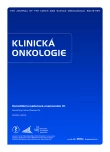Fanconi Anemia, Complementation Group D1 Caused by Biallelic Mutations of BRCA2 Gene – Case Report
Authors:
A. Puchmajerová 1; K. Švojgr 2; D. Novotná 1; E. Macháčková 3; D. Sumerauer 2; P. Smíšek 2; R. Kodet 4; M. Kynčl 5; A. Křepelová 1; L. Foretová 3
Authors‘ workplace:
Ústav biologie a lékařské genetiky, 2. LF UK a FN v Motole, Praha
1; Klinika dětské hematologie a onkologie 2. LF UK a FN v Motole, Praha
2; Oddělení genetiky a epidemiologie nádorů, Masarykův onkologický ústav, Brno
3; Ústav patologie a molekulární medicíny, 2. LF UK a FN v Motole, Praha
4; Klinika zobrazovacích metod 2. LF UK a FN v Motole, Praha
5
Published in:
Klin Onkol 2016; 29(Supplementum 1): 89-92
Category:
Case Report
doi:
https://doi.org/10.14735/amko2016S89
Overview
Fanconi anemia is a rare autosomal recessive disorder, clinically and genetically heterogeneous, characterized by typical clinical features, such as short stature, microcephaly, skeletal abnormalities, abnormal skin pigmentations, developmental delay and congenital heart, kidney anomalies etc. Pancytopenia leading to bone marrow failure occurs in the first decade. Patients with Fanconi anemia have a high risk of hematologic malignancies and solid tumors. The diagnosis of Fanconi anemia is based on cytogenetic testing for increased rates of spontaneous chromosomal breakage and increased sensitivity to diepoxybutane or mitomycin C. Fanconi anemia is a heterogeneous disorder, at least 15 complementation groups are described, and 15 genes in which mutations are responsible for all of the 15 Fanconi anemia complementation groups have been identified. Unlike other Fanconi anemia complementation groups, for complementation group D1 (FANCD1), the bone marrow failure is not a typical feature, but early-onset leukemia and specific solid tumors, most often medulloblastoma and Wilms tumor, are typical for this complementation group.
Key words:
Fanconi anemia – complementation group – FANCD1 – BRCA2 gene– leukemia – Wilms tumor – medulloblastoma
This work was supported by grant from Norway NF-CZ11-PDP-3-003-2014, MH ČR – RVO, UH Motol 00064203 and OPPK – CZ-2.16./3.1.00/24022.
The authors declare they have no potential conflicts of interest concerning drugs, products, or services used in the study.
The Editorial Board declares that the manuscript met the ICMJE recommendation for biomedical papers.
Submitted:
14. 7. 2015
Accepted:
6. 12. 2015
Sources
1. Alter BP, Kupfer G. Fanconi anemia. GeneReviews, last update: February 7, 2013.
2. Meyer S, Tischkowitz M, Chandler K et al. Fanconi anaemia, BRCA2 mutations and childhood cancer; a developmental perspective from clinical and epidemiological observations with implications for genetic counselling. J Med Genet 2014; 51(2): 71– 75. doi: 10.1136/ jmedgenet-2013-101642.
3. Hirsch B, Shimamura A, Moreau L et al. Association of biallelic BRCA2/ FANCD1 mutations with spontaneous chromosomal instability and solid tumors of childhood. Blood 2004; 103(7): 2554– 2559.
4. Kim H, D’Andrea AD. Regulation of DNA cross-link repair by the Fanconi anemia/ BRCA pathway. Genes Dev 2012; 26(13): 1393– 1408. doi: 10.1101/ gad.195248.112.
5. Shukla P, Solanki A, Ghosh K et al. DNA interstrand cross-link repair; understanding role of Fanconi anemie pathway and therapeutic implicatins. Eur J Haematol 2013; 91(5): 381– 393. doi: 10.1111/ ejh.12169.
6. Alter BP, Rosenberg PS, Brody LC. Clinical and molecular features associated with biallelic mutations in FACD1/ BRCA2. J Med Genet 2007; 44(1): 1– 9.
7. D’Andrea AD, Grompe M. The Fanconi anaemia/ BRCA pathway. Nature Rev Cancer 2003; 3(1): 23– 24.
8. Dewire MD, Ellison DW, Patay Z et al. Fanconi anemia and biallelic BRCA2 mutation diagnosed in a young child with an embryonal CNS tumor. Pediatr Blood Cancer 2009; 53(6): 1140– 1142. doi: 10.1002/ pbc.22139.
9. Howlett NG, Taniguchi T, Olson S et al. Biallelic inactivation of BRCA2 in Fanconi anemia. Science 2002; 297(5581): 606– 609.
10. Meyer K, Davies SM, Harris RE et al. The clinical phenotype of children with Fanconi anemia caused by bialelic FANCD1/ BRCA2 mutations. Pediatr Blood Cancer 2012; 58(3); 462– 465. doi: 10.1002/ pbc.23168.
11. Ried S, Renwick A, Seal S et al. Biallelic BRCA2 mutations are associated with multiple malignancies in childhood including familial Wilms tumor. J Med Genet 2005; 42(2); 147– 151.
12. Wagner JE, Tolar J, Levran O et al. Germline mutations in BRCA2; shared genetic susceptibility to breast cancer, early onset leukemia, and Fanconi anemia. Blood 2004; 103(8): 3226– 3229.
13. Meyer K, Fergusson WD, Oostra AB et al. A cross-linker sensitive myeloid leukemia cell line from a 2-year-old boy with severe Fanconi anemia and biallelic FANCD1/ BRCA2 mutations. Genes Chromosomes Cancer 2005; 42(4): 404– 415.
14. Miele E, Mastronuzzi A, Po A et al. Characterization of medulloblastoma in Fanconi Anemia; a novel mutation in the BRCA2 gene and SHH molecular subgroup. Biomarker Res 2015; 3: 13. doi: 10.1186/ s40364-015-0038-z.
15. Plevová P, Novotný J, Petráková K et al. Syndrom hereditárního karcinomu prsu a ovárií. Klin Onkol 2009; 22 (Suppl): 8– 11.
Labels
Paediatric clinical oncology Surgery Clinical oncologyArticle was published in
Clinical Oncology

2016 Issue Supplementum 1
Most read in this issue
- PALB2 as Another Candidate Gene for Genetic Testing in Patients with Hereditary Breast Cancer in Czech Republic
- Hepatoblastoma, Etiology, Case Reports
- Genetics of Colorectal Tumorigenesis (Possibilities of Testing and Screening Prediction of Hereditary Form of Colorectal Cancer – Lynch Syndrome)
- Fanconi Anemia, Complementation Group D1 Caused by Biallelic Mutations of BRCA2 Gene – Case Report
